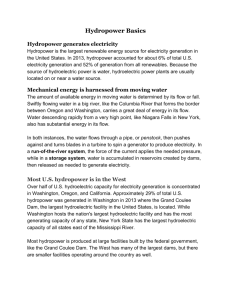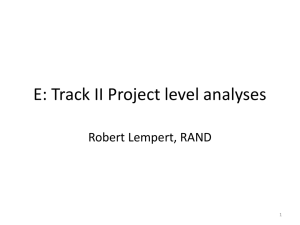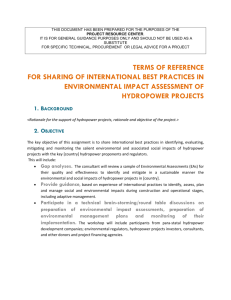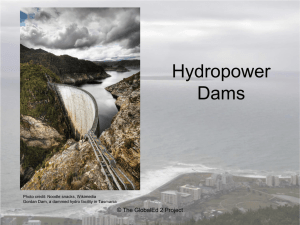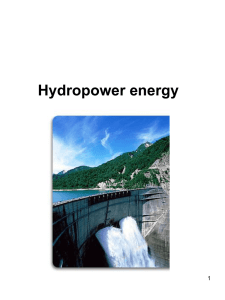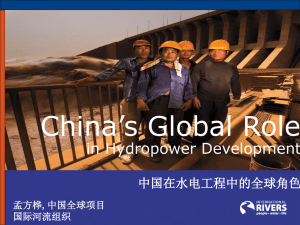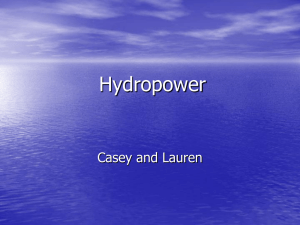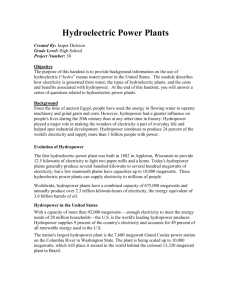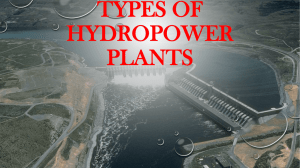hydropower i
advertisement
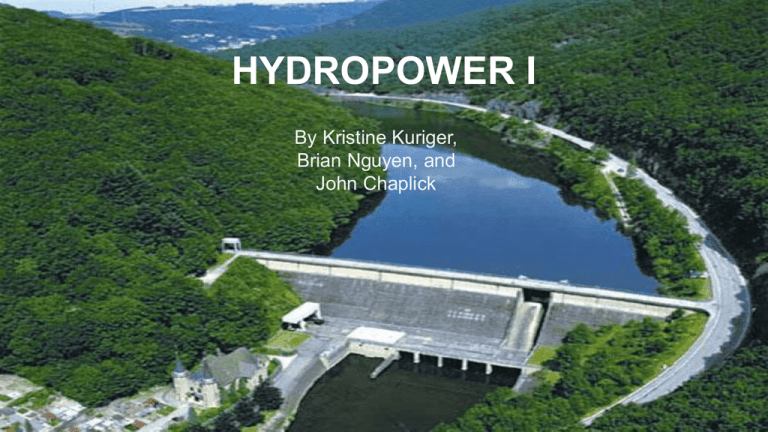
HYDROPOWER I By Kristine Kuriger, Brian Nguyen, and John Chaplick Topics to Discuss ❖ ❖ ❖ ❖ ❖ ❖ ❖ Hydropower Support General Opinions on Hydropower Hydropower Development Environmental Issues of Hydropower Social/Political Issues on Hydropower Is hydropower TRULY sustainable? Laws Regarding Hydropower Supporting Hydropower ❖ 25% of Earth’s energy (10% US) ❖ Hoover Dam ➢ 4 billion kWhr a year ■ 1.3 million people ❖ 90% efficiency in modern systems ❖ UCS: ➢ est. 67 million homes can be powered via waves, tides, currents ■ ➢ GULF STREAM: ■ ❖ 2025: 13,000 MW power .1% of its energy = 35% Fla. electrical needs PA: job prospects 3X higher ➢ Voith Hydro: power to 100,000 + homes; ➢ 2021: 18.5% energy will be HYDRO Public Viewpoint: Divided Duncan Graham-Rowe Hydropower isn’t “clean” ➢ 3 ½ times CO2 emissions as oil ➢ Plant decay Consumers “How much will this cost?!” “Who cares about hydro” ❖Power transfer needed, but at what cost? ❖US: no heavy research into its usefulness; WHAT IS IT? Environmentalists “Keep our ecosystems natural!” ❖Too risky for organismal/ human ecosystems Can Production be enhanced in areas where hydropower is already developed? •Yes, by upgrading and increasing the efficiencies and capacities of existing facilities. •The Water Power Program supports the hydropower industry and complements existing investment through the development of new technologies and key components. •There’s already three of the Water Power Program’s hydropower efficiency projects sponsored through the American Recovery which resulting in an increase of more than 3,000 MWhr per year. Developed Hydropower Area (Enhanced) •Cushman Dam in Washington: –Installed two Francis turbine/generator units which add approximately 3.6 megawatts of annual electrical generation. •Boulder Canyon Hydroelectric Project, Colorado: –Installed a new turbine/generator unit which resulted in a 30% increase in generations and an 18-48% increase in turbine efficiency. •Abiquiu Hydroelectric Facility, New Mexico: -Installed a low flow turbine which boosts an overall output from 13.8 megawatts to 16.8 megawatts Environmental Impacts While hydroelectric power is considered one of the safe, clean green sources of renewable energy, it does have its environmental impacts. The main issue involves how the actual physical environment has changed. This isn’t an issue so much for the wave farm and small run-of-the-river types of hydroelectric power, but more for the large dam and turbine types. While all types of hydroelectric power have problems, such as wildlife getting caught in the turbines, the biggest issue is the reservoir that is created in front of the large dam types power stations. These large lake sized reservoirs instantly swallow up and change the environment. Environmental Impacts (CONT.) The problems that arise from this are as follows • fish caught on the shallow end of the power station have little or no habitat left • plant life on the shallow end die due to loss of water (this can also produce green house gases in certain tropical areas) • the habitat of fish on the lake side changes, and interrupts migratory patterns • being that the water is deeper and more stagnant than before, it becomes more nutrient rich and can sustain large blooms of algae that can deoxygenate the water and kill other plants and animals • the algae has to be either regularly harvested, or certain species of fish must be introduced that eat the algae • these must be introduced carefully as to not change the existing food chain distribution. • In areas where the land is flat, a dam generator uses and incredible amount of land space • For example in brazil the Balbina hydroelectric plant flooded 2360 square kilometers, with a electricity yield of 250 MW or 2000 square acres per MW • Compared to smaller run-of-the-river plants built where there is depth to the water, such as a valley, can create 1 MW for only every 2.5 or so acres depending on size. This is a great difference Social and Political Issues The social and political problems with hydro power are much less easy to distinguish. One problem is a holdover from the environmental problems, the creation of the large reservoirs. While this may not seem to be a political or social problem it is. These reservoirs, especially the large ones like China’s Three Gorges dam, cover huge amounts of previously unflooded land. Social and Political Issues cont’ Funding is the other huge part of the political and social problems. Hydroelectric power plants are extremely expensive to build, and take a very long time to construct. Is Hydropower Truly Sustainable? •Hydro plants were built to last for 100 years but because of the environmental factors, many dams useful working lifetime is shorter –Things like: >Filling of reservoirs with sediments, evaporation, and less water availability from snowpack due to climate change. melting •For example, the Hoover Dam has reduced power production by 23% since it came into operation, and in 2010 was at the lowest levels it has been since the 1930’s when it was filled. –Water levels in the lake will conceivably be low enough by 2025 to require operators to shut off power production that 29 million people depends on. •Large Dams are Unsustainable Laws and Regulations of Development of Hydropower •Before adding a new hydropower in an area, they must face a comprehensive regulatory approval process. –Things like the Federal Energy Regulatory Commissions, federal and state resource agencies, local governments, tribes, NGOs, and the public –This system protects the important environmental values. •The downside of this process is that it’s very inefficient and unnecessarily slow for the deployment of the hydropower and can be delay (much needed up to 2-3 years) for environmental enhancements and benefits. To Conclude: ❖ Hydropower has tremendous potential in being a top electrical producer worldwide, BUT it seems as if the world is split between wanting to explore our options and keeping things as they are ❖ While hydroelectric power isn’t a concern for greenhouse gases, as is usual, it is an enormous impact on the environment and must be monitored and planned carefully. ❖ Hydropower can be enhanced by upgrading and increasing the efficiencies and capacities of existing facilities. ❖ Large dams are Unsustainable, because of environmental factors such as infillings of reservoirs with sediments, evaporations, etc. ❖ Before adding any new hydropower in an area, they must go through a comprehensive regulations. Sources Used http://library.thinkquest.org/C004471/tep/en/traditional_energy/hydroelectric_power.html http://www.newscientist.com/article/dn7046 http://www.enviroliteracy.org/article.php/59.html http://www.ucsusa.org/clean_energy/our-energy-choices/renewable-energy/how-hydrokinetic-energy-works.html http://www.nrel.gov/docs/fy04osti/34916.pdf http://www1.eere.energy.gov/water/hydro_technology_development.html http://www.wellhome.com/blog/the-pros-and-cons-of-hydropower/ http://blog.sustainability.colostate.edu/?q=content/not-so-clean-hydropower-damming-us-all http://www.hydro.org/tech-and-policy/policy-priorities/more-efficient-regulatory-process/ http://www.youtube.com/watch?v=cEL7yc8R42k



